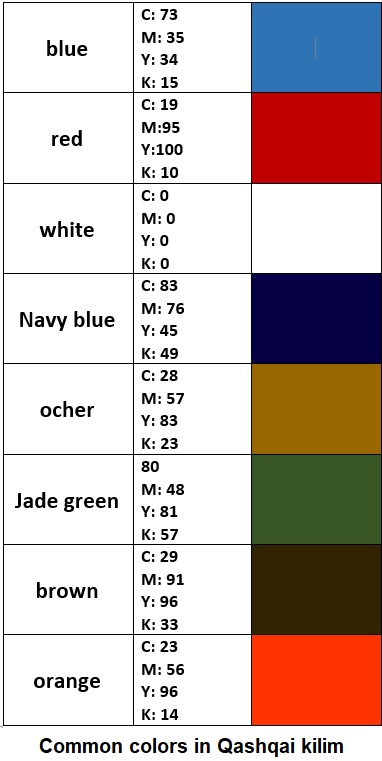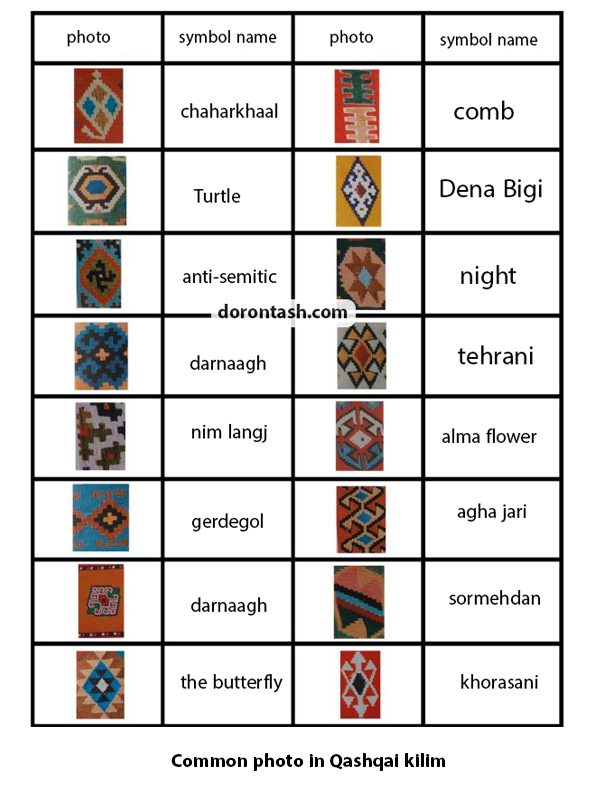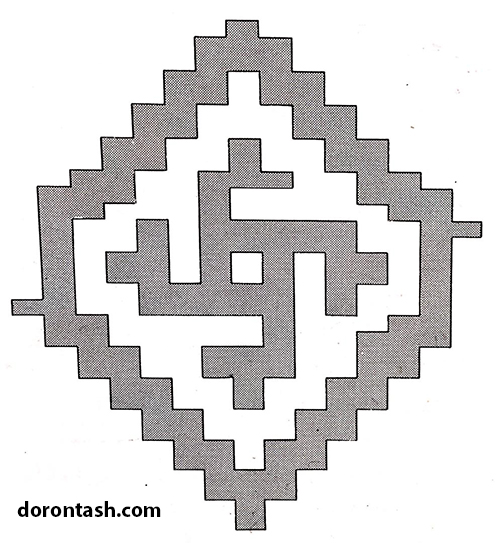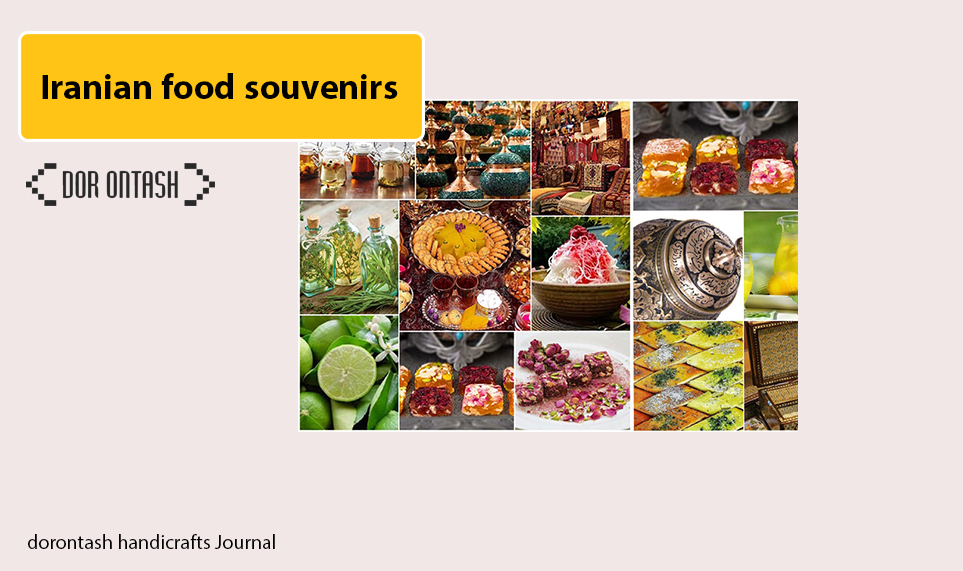kilim pettern symbol used
The designs used in these kinds of weaves are generally geometric kilim pettern symbol that have different shapes, such as: triangles, rhombuses, hexagons, and squares. Of course, many original and traditional motifs decorate the face of Iranian rugs, which sometimes take the shape of animals and nature, and sometimes are cashmere, flowers, and bushes. The different designs used in these arts depend on the type and region in which they are woven.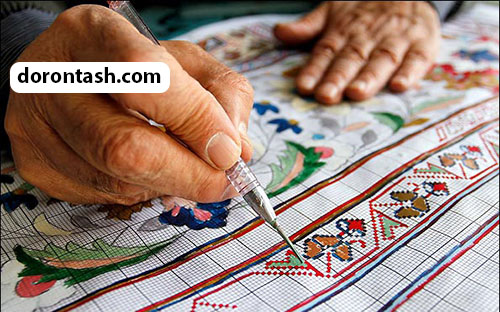
The history of the kilim
After man was able to make clothing from animal skin, he gradually thought of using wool and skin for bedding. When humans invented wool spinning, because they are always preparing comfort items, kilim weaving was created so that humans no longer sit on the dry and cold ground.
Based on historical evidence, the history of this beautiful and valuable art reaches 2500 years before Christ; The oldest woven carpet from this era was discovered among the ancient Egyptian artifacts.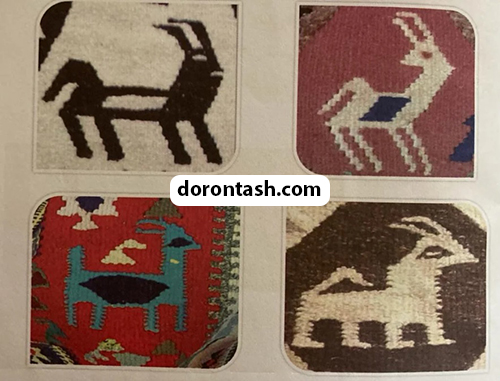
Persian rug, a survivor of the original ancient art
A rug of Turkish origin is a thick woven fabric that does not have threads or long fibers and has many uses and is produced by one of several flat weaving techniques. In fact, the main difference between a carpet and a traditional rug is the long knotted fibers in the carpetIt exists and the traditional carpet lacks it. The pattern of the carpet is formed with the help of these fibers and by different colors, while the traditional rug designs are made by mixing different colored taropods. Traditional carpet has a long history and has seen many empires over thousands of years. The traditional carpet is the common heritage of different geographical regions such as Turkey (Anatolia and Thrace), North Africa, Balkans, Caucasus, Iran, Afghanistan, Pakistan, Central Asia and China. Traditional carpets have been used for various purposes since ancient times. Among the uses of traditional rugs, we can mention covering the floors of mosques, prayer rugs, bags and shoes, saddle covers, wall decorations and handicrafts of nomadic peoples.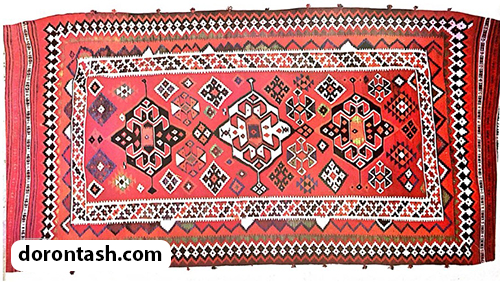
The structure of the kilim
The rug is produced by interlacing the woven taropod yarns, creating a smooth, lint-free surface. The weft threads, which have a visible design and color, are usually made of wool, while the warp threads, which are hidden under the surface of a traditional rug, can be wool or cotton. We can see the threads like carpet roots only at the end, where they appear as borders. Threads are usually tied in bunches at the roots of traditional carpets to prevent the fabric from loosening or unraveling. In this case, the horizontal weft strands are firmly pressed down so as to hide the vertical warp strands.
All kinds of handmade and Iranian kilim models and kilim pettern symbol
1- Simple or flat kilim
This type of carpet, which is also known as two-faced and plain, as can be guessed from its name, is woven in a simple style so that the two sides of the carpet are completely the same and both sides of the carpet can be used. .
This type of carpets is less thick than other models and it can be said that it is the most common option among the types of handmade carpets. Qashqai, Sane and Bijar carpets in Kurdistan, Musand and simple carpets of Ardabil, Semnan and Zanjan are in this group.
2- one-sided or varnished kilim
This type of rugs, which is also known as Sumak, is less thick than the previous option, has a twisted texture, and has a Caucasian appeal, and has been woven in Iran and Turkey for a long time.
The first weavers of this type of rugs were nomads, and as you must have guessed, it should be more popular in the Turkish-speaking regions of Iran. Varni is actually one of the types of rugs in Ardabil and East Azerbaijan provinces, which has geometric patterns, animals and simple motifs.
3- Embossed or tufted kilim
Among the types of hand-woven rugs, this type is most similar to hand-woven carpets, and it is done in this way: the carpet is tied on the skein from the pattern, and at the end, the piles or the extra creams are picked.
Of course, it is necessary to point out that in this type of rugs , the background is designed in a simple way and different designs and maps are not used much like carpets.
Factors affecting the formation and emergence of Qashqai carpet motifs
The motifs and designs of Qashqai rug show the creative mind, rich intelligence, tireless effort, high strength, gentle nature and depth of thought of its weavers. Knowing these motifs and designs makes us better understand the religious context, beliefs, the truth of life, myths, the structure of customs and traditions of this tribe. Also, we will find out the effective factors in the emergence or forgetting of motifs in the history of this people. In general, the titles of important and effective factors in the emergence of Qashqai carpet motifs can be considered as follows: a) geographical factors and surrounding nature b) history, culture and art of Iranian nomads) management system c) level of literacy and knowledge and income and livelihood of people The most important results of this research include: the classifications of Qashqai rugs, the most common designs, motifs and sizes of Qashqai rugs, designs that have been changed and forgotten, and the use of various colors in Qashqai rugs.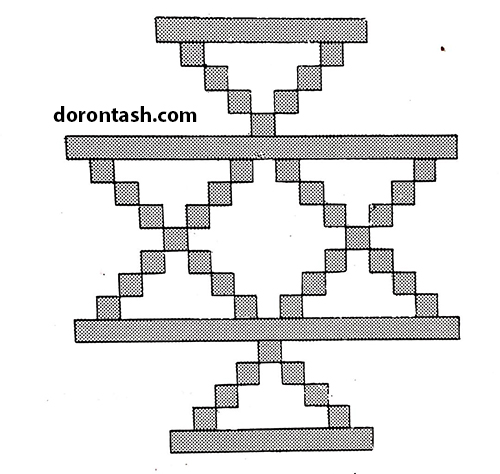
kilim patterns
Many motifs are used in Iranian rugs , each of which has a great diversity in its own kind. Geometric shapes are the most repeated designs in traditional Iranian rugs, which are derived from shapes such as rhombuses, squares, rectangles, triangles, etc., in addition to geometric designs, a combination of animal, human, and plant symbols can also be seen, each of which It is a symbol of a belief and thinking. One of the designs that can be seen in the patterns of traditional rugs is Rab-ul-Nauw Mother, which is a female or maternal figure with a fertility state, as well as male and female motifs, both of which are symbols of fertility. Among the animal motifs used in the designs of traditional rugs, we can mention snake and dragon, crab, turtle, horse, ram, all kinds of birds, goat, etc., each of which expresses belief in a specific phenomenon in the belief and culture of different nomads and tribes. .
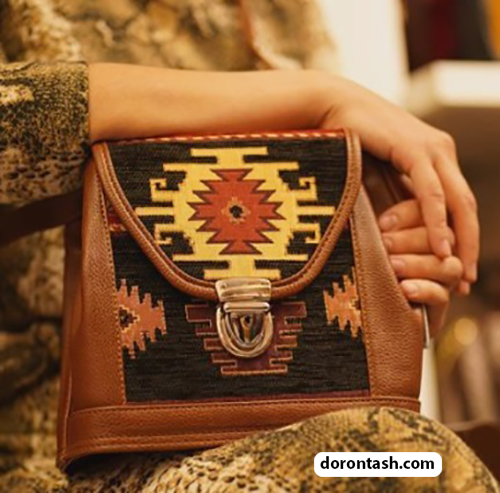
Goat symbol on pesrian kilim bags
Rhombus motifs are one of the most frequent geometric symbols in Iranian carpets , because they have long believed that rhombus motifs repel demonic forces. The triangle is another design used in the traditional carpet with geometric designs that indicate a kind of amulet and protection against the devil, and for this reason we see the triangle motifs on the border of the traditional carpet as a cover and protector of the rhombus designs. Finally, we see plant motifs in some traditional rugs, which are a symbol of life and power, and have been found abundantly in Iranian motifs and paintings since ancient times.
Research on carpet weaving motifs has 3 interrelated stages:
1. Analyzing the structure of various textures and its limitations in patterning and geometric shapes
2. Investigating the history of nomads, migrations, way of life, religion, beliefs and superstitions
3. Investigating the emergence and expansion of such designs in family traditions and native culture of single-settled villagers.
Undoubtedly, the lack of technical possibilities in weaving limits the design and patterning and requires a different composition from the map to the design of a picture.
In the balanced weave, which is the simplest way of weaving, which has threads and wefts visible on the surface of the weave, patterning is only possible in the form of round or empty dots. If the threads are as usual and the wefts are beaten with a comb, there will be paths in the color of the beaten weft or tar, which is known among the nomads as “Tar-Roo” or “Pod-Roo”.
This type of texture is often used together with decorative textures. The “grooved texture” has made the weaver’s desire to break the “paths” and make patterns with different squares possible. Strands of the weft of one color are wrapped around the warp and create a gap between that warp and the adjacent warp, which is seen as a border between the colors. In this way, it is possible to obtain square pieces of color, which, by adjusting them, various shapes appear. With this type of texture, due to the limitations of weaving and the need to reduce the distances, only triangular, diamond-shaped, stepped and 90 and 45 degree angles are produced. Of course, complex and advanced motifs are also drawn with these simple geometric shapes. Among the groups that weave rugs with similar motifs and designs, Qashqais, Elsons, nomads of northern Afghanistan and central Anatolian tribes can be mentioned.
A balance of color and positive, curved and symmetrical roles can create harmony or a pleasant contrast in the composition. This kind of role-playing is a reflection of the duality that prevails in Eastern Sufi thinking and Islamic concepts: black and white or winter and summer, death and life or good and evil. In the book “Sufi: The Manifestation of Mystical Path” it is stated:
The duality manifested in geometry with dynamic and static forms exactly corresponds to the conventional spiritual stages that the Sufi always goes through: contraction, expansion/difference, accumulation/consciousness, non-self/being, non-existence/presence, absence.
Sufi thoughts can be seen not only in Islamic art, architecture and calligraphy, but also in the patterning of nomadic rugs. The space around each pattern, which can be independent or an extension or reverse image of the other, is very important in the overall plan of the weaver.
Birth month symbol
Mother Rebbe: A body of a humanoid rebbe sometimes seen with a baby in the womb, which symbolizes life/birth and the desire to give birth to a baby. These images appear as a single image and a mirror image in the background and margins.
Ram’s horn: The eternal power of ram’s horns is a manifestation of masculinity, male fertility, strength and courage. While weaving this image, the woman hopes that her husband’s strength will be indestructible and his strength will overcome time. It is believed that these pictures originated from the spiral pattern, which is a sign of immortality.
Barkat: These images are created by mixing the above two images and are a manifestation of fertility. Multi-seeded products and fruits also mean fertility.
Man: The human body means waiting for a baby and also means honoring the memory of the dead.
Pictures of life
Comb, head flower or earrings: these pictures show the weaver’s desire to get married. The comb or flower head is the bride’s jewelry and the earring is one of the gifts she receives.
Animal binding: This symbol means family ties. Although it can also be a sign of the continuation of family interests, which is the result of such a connection.
Box: It is a symbol of the chest of the bride’s dress, where her personal belongings are placed for the wedding night. From childhood, girls prepare for marriage by weaving all kinds of carpets, rugs, khorjins and bags to carry very personal items and embroidering on clothes, shawls and waists. The girl’s various belongings, which are not used in any way before marriage, are kept in chests which are kept in very beautiful carpets. Elsons and Caucasians weave special carpets for this work.
Yin-Yang: Desire for harmony in the relationship between men and women.
Star: It is generally a sign of happiness. In Anatolian rugs, eight-pointed stars are often used due to technical limitations and principles.
Pictures of life protection
Flowing water: Since there is no life without water, this very important image is the embodiment of life and is usually placed in the margins of the rug.
Baba Adam plant: A plant that produces flakes that stick to everything, these flakes can be seen in the roots of carpets whose background has lost color due to light radiation.
Hand, finger and shoulder: symbols of fertility that indicate the hand of Hazrat Fatima (PBUH). The shoulder indicates the desire to get married and protect the family and babies from the evil eye.
Amulets and sore eyes: In Anatolian beliefs, a person’s gaze can kill, injure or create misfortune. Since the human eye is the source of bad opinion, so the best prevention is to draw an eye. Patterns drawn from the eye neutralize the effect of the wound eye and keep people safe from it. For this purpose, Khurmahreh, which is read as the victim’s comment, is the most common spell. But other objects such as silver, gold, other metals, as well as wild mustard, garlic, turtle and all kinds of oysters have been found to be effective. A talisman is a written talisman that is kept in triangular covers and has magical religious power against a sore eye. Since there is still a fear of the scarred eye, many rug images protect people from it, and considering their totemic designs, some of the old rugs are apparently woven for this purpose.
Nazar Ghorbani: Nazar Ghorbani is made in the form of various wall hangings, usually it is in the form of felt covered with fabric and decorated with shells, buttons, coins, medals, old pieces of various items, mirrors, rugs and carpets and in various forms. It is made round, oval or pear-shaped. In the lower part of some of these wall amulets, ribbons are woven and woolen tassels are hanging from the main body. It is sometimes made with colored pieces of ceramic or glass, or peas are strung in a triangular shape and hung from a thin piece of wood, and colorful cloth and wool strips are added to it.
Wounded eyes paintings
Wounded eye pattern: Usually, this pattern is diamond-shaped, but sometimes it is also seen in a square or triangle shape.
Chelipa: It is a very old image that dates back to the pre-Christian era and is used to protect against sore eyes because its cross combination reduces the power of sore eyes.
Hook: Another image for protection against sore eyes.
Snake: symbol of fertility, happiness and mobility.
Dragon: Lord of weather and author of the tree of life and guardian of the secrets of the galaxy. The dragon as a symbol of fertility has also been very popular in Caucasian rugs and carpets, especially Visha Pagreg rugs. This pattern can be seen in the patchwork rugs called “needle dragon” or zili. Images of smaller dragons are also used in the margins or as additional decorations.
Scorpion: The weaver protects himself against this poisonous creature with this image.
Wolf’s mouth or paws: since the desert dwellers were herders, wild animals have always been considered a deadly danger for them. This picture is drawn for protection against wild animals.
Pictures of life after death
Bird: It is said that the collective flight of birds is a sign of spiritual entry into heaven. The vulture is a symbol of death and the sign of the soul of the dead. This picture is more meaningful than other pictures and is more alien to the bird symbol because the bird is a sign of love, tidings, happiness, pleasure and also a manifestation of strength and power.
The tree of life is a symbol of immortality. Man does not attain the legendary fruit of the tree of eternal life. But by carving it, he has the hope of life after death. Religions that believe in one God. They often use this symbol and it is interesting that in rural houses, carpets with this pattern are hung from the bottom to the top. This action shows the belief that the roots of this tree are in heaven, the source of all powers, and are transferred to earth through its branches.
Other pictures – kilim pettern symbol
In some handwoven rugs, besides various symbols and images, various visual messages in the form of numbers and Arabic alphabets are also evident.
An inscription from right to left shows the name of the weaver or the person for whom the rug is woven, and a short religious message such as “Allah Akbar” may be seen in the rugs. They use Russian letters in the Caucasus and Latin letters in Turkey.
The dates that the Armenians living in the Caucasus, Eastern Anatolia and Iran have woven into the carpets belong to the Georgian calendar. Other dates, especially if the figures are in Arabic. It belongs to the Islamic calendar, which can be converted to the Georgian year by dividing it by the number 33 (the Islamic year is about one thirty-third or 11 days shorter than the Georgian year) and subtracting the remainder from the original date. Until the middle of the century, Iranian weavers were influenced by traditional and ancestral paintings. Despite the political pressures that caused forced migrations and the collapse of nomadic communities, these inscriptions are still standing.
The common origin and background of Turkish images, especially the eight-pointed star, can be easily recognized before other images. However, the background of the paintings and paintings has little indigenous culture, although some of these paintings are known as talismanic paintings to fight evil and bring good luck. But it is surprising that a little further down in Afghanistan, a land with story-telling traditions, we can find a slight connection between paintings and paintings. For example, the rugs of northern Afghanistan are purely geometric, but the Bijar Turkmens include symbols of good luck and happiness in their rugs, which are related to success in hunting and related narratives. In the gloomy appearance of Baloch handwovens, various traditional images are hidden. Many of these motifs are clearly pictorial and depend on traditional narratives and indigenous culture.
If local and planned research is not done in these areas soon, these connections and meanings will be lost forever. Patterns and symbols have a great appeal, but they will never be equal to the pleasurable research about the rug.
Bird – kilim pettern symbol
Symbolic meaning: desire, freedom, sky, cloud, inspiration, wind, prophecy, messaging, soul reincarnation, breath, immortality, fertility, sun, divinity, spirit of life, spirit of air, growth, haste, child.
Ethnic and Mythological Beliefs: Revealing the Secrets of the Gods. Protector of the tree of knowledge. The tree of life, the killer of the snake, in the legend of the Indians, a personification of the soul in heaven; Also rain, thunder, carrying the dead to heaven.
Bird’s Foot Effect: Prophecy, Origin of Alphabets
Man with a bird’s head: Spirit
Wings of a bird: wind, imagination, thinking, divine mission, intelligence
Feather: literature, lightweight, writing
Migratory birds: swallows, wild geese, messenger pigeons
Bird of Athens: Owl
Bird of freedom: Eagle
Bird of the United States: Eagle
Bird with golden eyes: divinity
Ominous bird: crow
Bird of Paradise: Constellation Apus
Blue bird: happiness
White bird: the soul of pious people
Black Bird: Evil Spirit
Red Bird: In China and Japan, one of the four good spirits
Juno bird (Jurno): male peacock
Long-legged bird: long life
Bird in the bush: means what is wanted but not yet achieved.
Bird Eating Grapes: Eternal Life in Ancient Greek and Hebrew Tradition
Bird in the hand: ownership
A bird in wine: a soul that benefits from heavenly food.
A bird in a cage: man in the shelter of God in the womb of the mother goddess.
“Diomedes” bird: swan
Bird on high (stone pillar): union of spirit and matter, royal authority and ability
The bird released from the cage: the flight of the soul to the sky
Arabian bird: Phoenix (Simorgh)
The bird of the country of Japan and the Netherlands: stork
Wild bird: bad omen
The bird and the turtle: the union of opposing forces
Flight of the bird: the flight of the soul to another world, a means of divination
Claw with a bird’s foot: in family regalia, the sign of an eagle as a sign of a hunter
Bird’s language: warning, message-carrying, a means of advice, the main subject of folk literature.
Scepter or pointed bird’s head: ability and power, member of royalty, sign of a holy person.
Boat in the shape of a bird: carrier of the dead.
Bird cage: trouble, dream interpretation: slander
Flying Serpent: Heaven and Underworld, carrier of the dead, good and evil, earth and air, controlling forces of natural forces.
Love bird: Lunar
Dream interpretation: good news
Nightingate – kilim pettern symbol
Symbolic meaning: anticipated happiness, sweetness, also destitution, loneliness, ominousness, unwanted love
Ethnic and Mythological Beliefs: In Japan, the happy songstress, the harbinger of spring in artwork, this bird is depicted among the blossoms of a plum tree.
Quail – kilim pettern symbol
Symbolic meaning: doomsday, also lust, debauchery
Ethnic and mythological beliefs: a personification of the gods of dawn and spring, the sacred bird “Apollo” and “Melkarth”. In China, it is a symbol of courage. In the Old Testament, heavenly food.
Turkey – kilim pettern symbol
Symbolic meaning: pretense, show off, pride, pride, also lack of success, especially in theatrical affairs. Ethnic and Mythological Beliefs: The sign of the fourth Thursday of November, which Americans celebrate as Thanksgiving Day (for the first day of harvest). Mayan rain giver.
Male turkey: the arrogance and boldness of the government official.
Turkey Dance: Among the Indians of the coast of North America, a dance of love and wooing, which imitates the movements of a turkey.
Pelican – kilim pettern symbol
Symbolic meaning: donation, charity, benevolence, parental love. Also bodybuilding. Stupidity, social life, melancholic parentage and migration.
Ethnic and mythological beliefs: the pelican is considered a symbol of rebirth and resurrection. In family honorifics, the pelican is drawn like this, standing on its nest with its wings folded behind. It is feeding its chicks. This state is considered a manifestation of piety and piety of the pelican. In Christian art, as a symbol of atonement, the pelican injuring itself, representing the crucified Jesus.
Jagged (OWL) – kilim pettern symbol
Symbolic meaning: vision, thinking, wisdom, silence, night, messenger of witches, carnivorous beast, spirit.
Ethnic and mythological beliefs: Owl hooting around the house is considered a sign of calamity, illness, calamity and death. In many places, the owl is considered lacking in originality and race, and the hunting of this bird is considered unlucky. In the signs of family decency, the sign of an alert person, great reasoning power. Moderation, lack of education and leadership, lack of imagination and imagination, moderation, order, bird attributed to the gods, sunrise, sacred bird “Athena” (Athena) in Egypt symbol of darkness, cold, death.
Swallow – kilim pettern symbol
Symbolic meaning: bright sun, displacement, hope, morning, equality, spring of perseverance, supporter and maintainer
Little children, new birth, happiness, good luck, half-way mate, prosperous life, builder, contentment in poverty, migration.
Ethnic and mythological beliefs: in the signs of family decency, the symbol of a person who is ready and willing to do his work; The bearer of good news in Christianity, the symbol of prayer (because Chalcheleh is hungry most of the time).
Reincarnation of Christ: In Egyptian mythology, “Isis” (lsis) appeared in the form of a fountain after finding “Osiris” (Osiris).
Chick-fil-A: In Christianity, the symbol of a person who goes to feed the Afghan soul.
Geometric patterns
In the explanation of these motifs, it should be said that a group of rug designs that are the result of arranging simple and symmetrical geometric shapes from triangles to octagons are among geometric motifs.
Another group of symmetric repetitions of a particular image is in the way of left and right arrangement and in terms of positive and negative coloring. In this “full and empty” painting style, another painting with the same shape and size but in light color is revealed in the empty space between two dark paintings in the opposite direction, which is objectively and directly derived from the symmetry of the dark or positive painting.
symbol of Sarme Dan
It is composed of a central rhombus and six triangles or semi-rhombuses that remain in the sarmehdan. Sarme Dan is mostly placed in the distance between other pictures and sometimes it falls in an octagonal frame, which is used as a frequent motif in upside-down designs.

Another type of Sarme Dan is the result of placing a simple Sarme Dan motif in the center and surrounding it with triangles and other rhombuses. As a result, a bigger kidney is formed, which has a small kidney in its belly. Both types of Sarme Dan are motifs that are decorated with many rows of Qashqai rugs without laces and fringes.
These motifs are one of the most common Anatolian Glimbafi motifs, and it is believed that Qashqai brought them to Fars with them.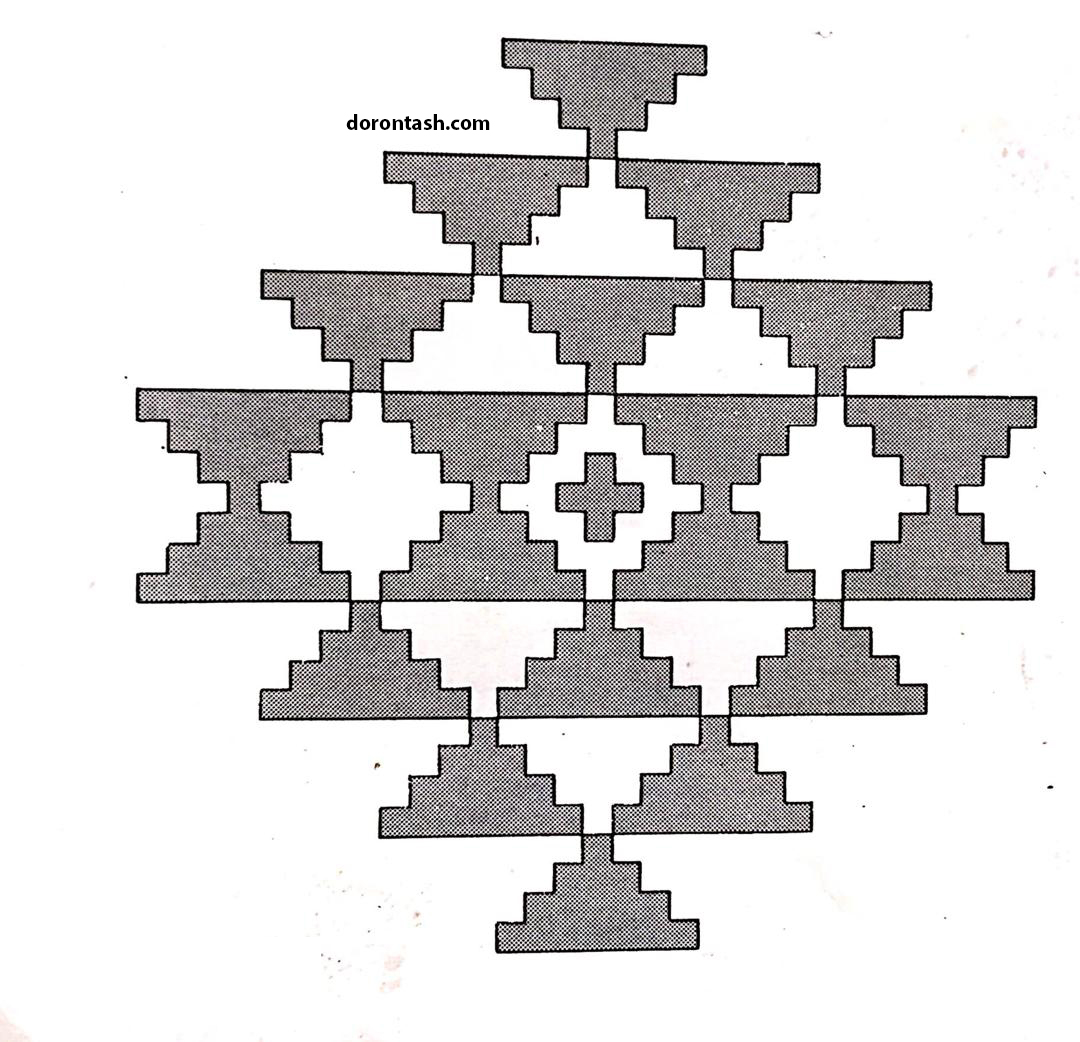
Checkered pattern
This compound pattern consists of placing 9 small rhombuses inside a large rhombus, which has four small rhombuses placed in a mutual and similar manner along the lower and upper angles.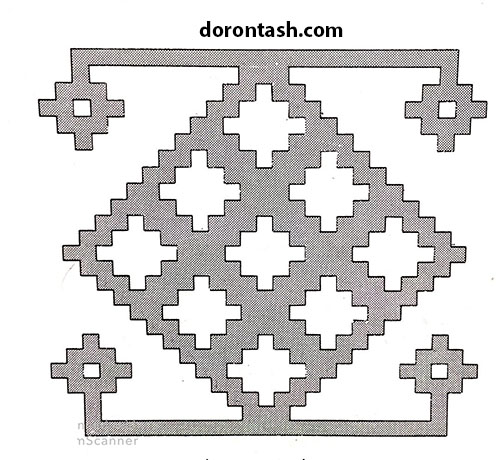
A pseudo-reasonable character
In this pattern, the main broad lines all have a right angle, as if each line is an independent rectangle connected to other rectangles in the same way as bricks and rectangular tiles are put together.
The influence of architectural styles in the development of these carpet motifs is not limited to the main and central patterns and the design of their frame, which is always rhombus-shaped, is called “soap flower” architecture.
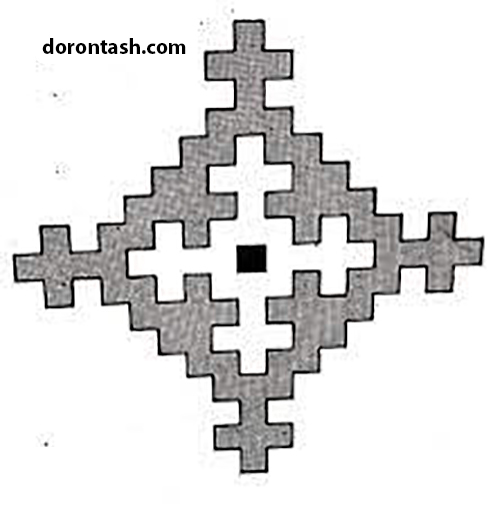 Dual roles
Dual roles
All motifs that are included in this group are rooted from a pattern known as “Ital” or “dog’s hand” in the tradition of Qashqai weavers, and in its simple and raw form, it is the quadruple arms that are made of four mutually connected patterns that are not similar to a dog’s hand. It is not, it has been combined and this role is known as “Qosh” in some Qashqai provinces. 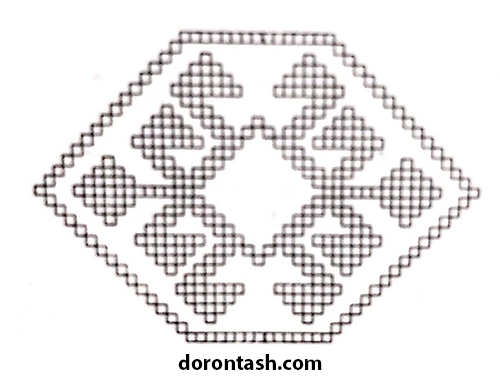

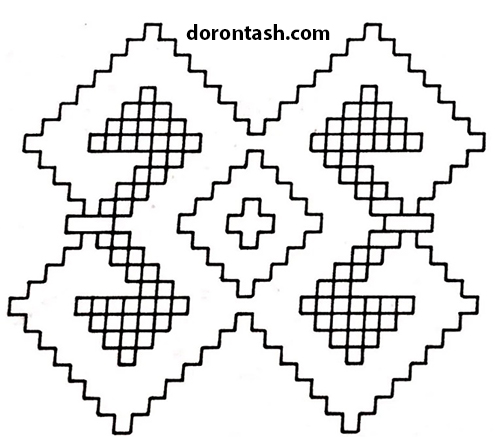
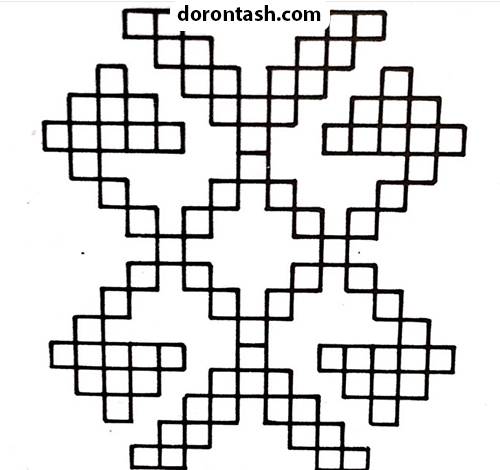
This motif, very common in Iranian carpets, especially Qashqais, is wrongly called crab by western carpet experts. The ETL pattern is divided into five forms: simple ETL, ETL in a double frame, ETL in a frame with a hexagonal middle, ETL with a double arrow middle, ETL developed in a hexagonal frame.

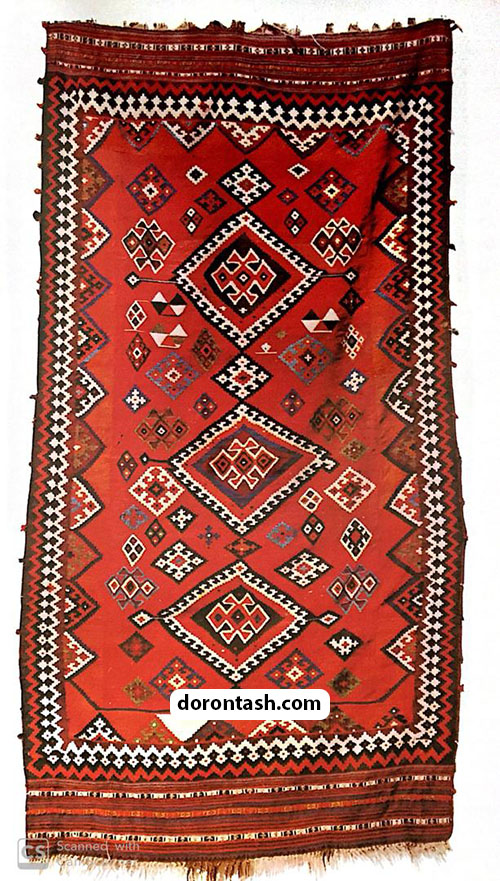 But there is a pattern similar to Ital, called Khorasani Naqshmaye, which was born from two pairs of chicken head motifs, similar to Ital. Finally, because these chicken pictures are placed back to back and crosswise, and their necks are connected to the middle rhombus, there is no empty space left between them to be filled with a negative picture.
But there is a pattern similar to Ital, called Khorasani Naqshmaye, which was born from two pairs of chicken head motifs, similar to Ital. Finally, because these chicken pictures are placed back to back and crosswise, and their necks are connected to the middle rhombus, there is no empty space left between them to be filled with a negative picture.
Consolidated role
We should briefly mention the motifs of this group, which are divided into five categories: Chin, Qezel, Chichi, Almagal, Shaneh, and Chichi.
china
There is a stepped rhombus motif with a cruciform motif in the middle and two opposite two-arm motifs, which the Qashqai people call Chin, and among some other clans, it is known as the ram’s horn. China is one of the motifs that is mostly used in chains and in connected rows, and that is why the Lors and Qashqais use China a lot in the design of the border of Geba.
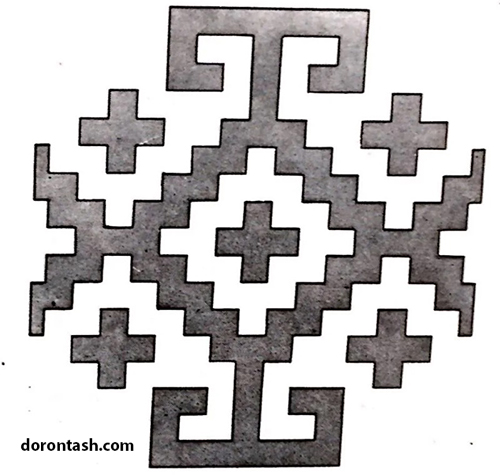 Scissors
Scissors
The Qashqai people call the eight-pointed star symbolizing the sun as Qezal Qechi, and place it inside the eight-pointed frame in the rug design. Qezel kichi is woven either simply and in one color or in a way where four feathers are of one color and four feathers are of another color.
It goes without saying that the abundance of star motifs in Persian carpet weaving is not because of its beauty, simplicity, and purity, but because of its ancient importance and the symbolic meaning of the star in the mythology of ancient Iran.
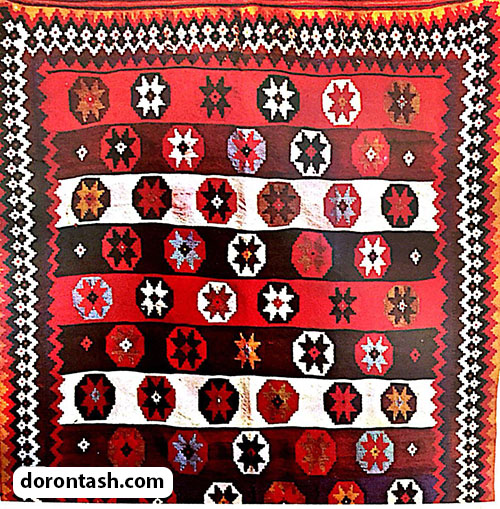
Alma Gol
This motif is a completely styled and geometric face of an ancient eight-petal flower. In this motif, the rotating petals and circular lines of the eight-petaled carpet flower have been transformed into square petals, and each pair of petals has become the same width and level, and it has come to a state where the first circular motif has become close to the four-armed cruciform motifs.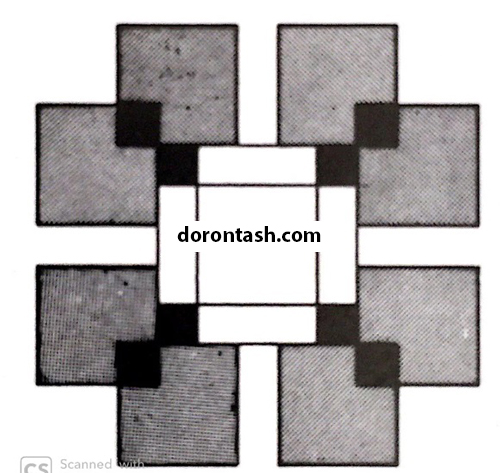
the comb
This motif is a representation of two-sided wooden and metal combs. The Qashqais always weave it together with the scissor pattern in wide horizontal strips.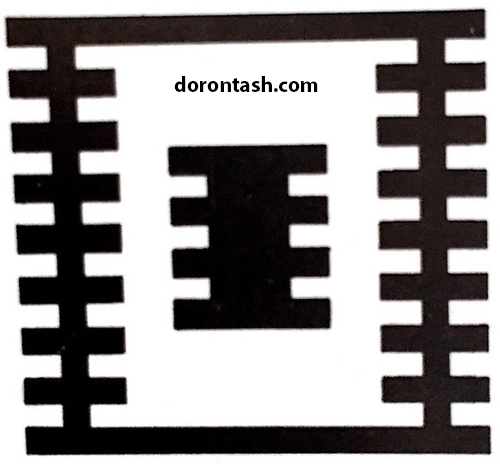
scissor
Four open blades like scissors on the axis of a rhombus. Compared to other motifs, this motif is less abundant in Qashqai weavings.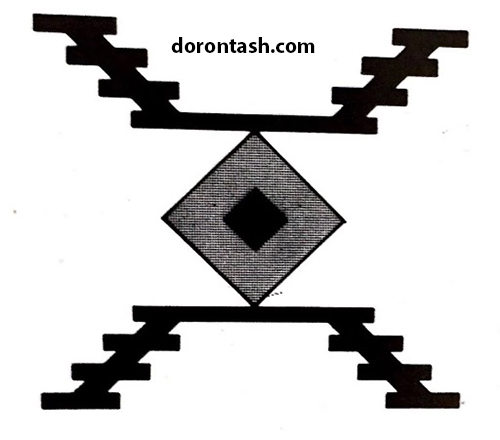
entrances
The marginal motifs of these motifs are divided into 3 completely separate categories.
This is the most common border pattern, which is called “Abbasi tulip”, apparently inspired by the mythological codes of ancient Iran, in the same sense as the entrance to the sky and the door of the throne.
The oldest example of the border of the entrance in carpet weaving has been continued since the Safavid era, and it is evident in the tiling of the dome of the tomb of Amir Timur Gorkani from the beginning of the 9th century of Hijri.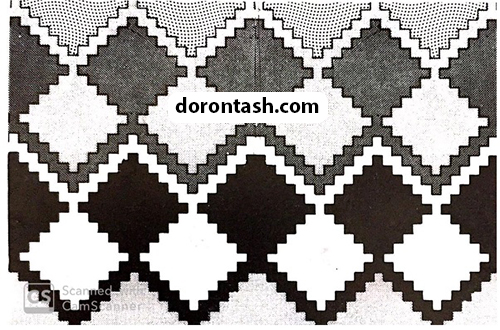
The border of entrances is also common in Glimbafi Qafaz, Asia Minor and areas of Azerbaijan, Kurdistan, Zanjan, Eilat Bakhitari and Afshar.
The second type of border of entrances, which is found from two rows of very fine crossed entrances, has only been seen in one very old rug, because this method of double and crossed entrances has not been found in any other carpet in the world.
lame
After the entrance motif, the most common and fruitful marginal motif of Fars rugs is Langaj, which is also common in Bakhtiari rugs. Langej is one of the composite border motifs that three different independent patterns are used in its creation.
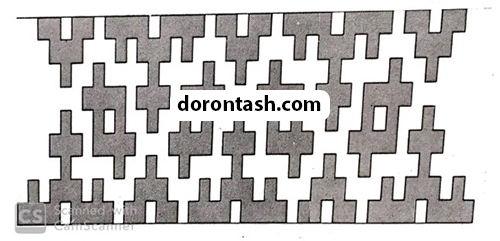
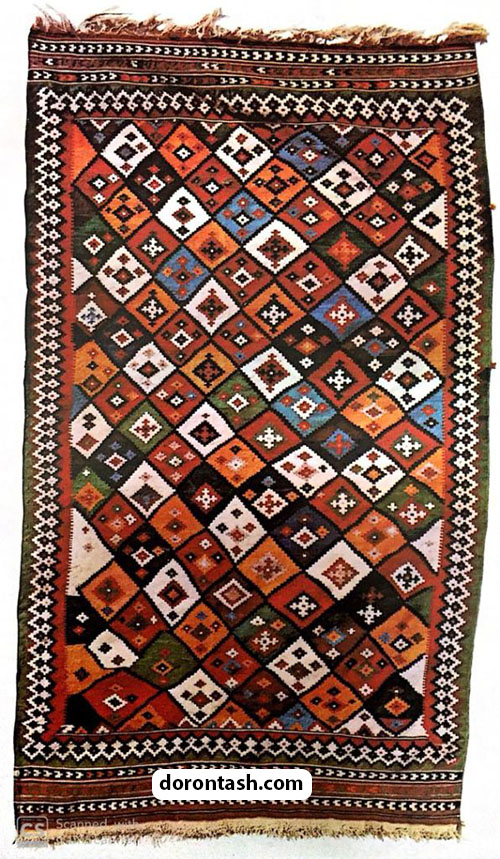 Cheplaqa and Ala Ghord
Cheplaqa and Ala Ghord
It is one of the motifs used in Qashqai Glimbafi for the sub-margins and to separate the two horizontal mahramat strips from each other. These two motifs are woven in the same way as motifs for full and empty or positive and negative design and dark and light coloring, just like motifs for netting the bottom of the carpet. Alakord is one of the motifs that entered Iran’s architecture after Islam.
kilim is one of the most famous iran handicrafts

